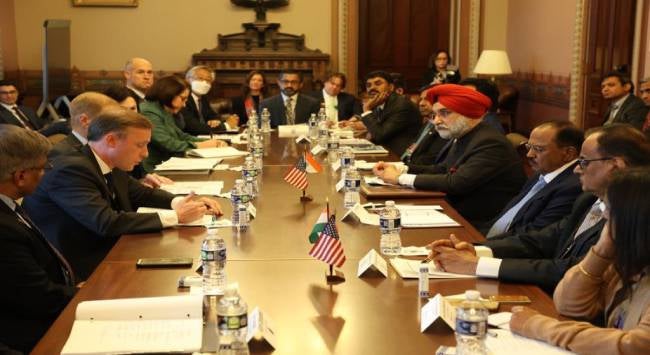Summary
The United States and India are forging ahead to establish and cement a technology partnership that could become defining to their relationship.
In May 2022, United States (US) President Joe Biden and Indian Prime Minister Narendra Modi announced the US-India initiative on Critical and Emerging Technology (iCET)to renew, elevate and expand their strategic partnership. Specifically, the initiative hopes to kindle technology and defence ties between both governments, businesses and academic institutions in their countries. During Modi’s recent visit to the US, the initiative became a key and central deliverable around which other initiatives were announced, reinforced and crystallised. Technology, surprisingly, and how it is developed, designed, governed and used has become a key bilateral focus for both countries, especially given China’s technological might. The iCET is a critical initiative and achievement for both countries but the momentum and energy have to sustain to entirely fulfil its ambitious mandate.
The iCET was formally signed in January 2023 when Indian national security advisor Ajit Doval visited Washington. After that, both sides announced several research initiatives to boost cooperation on issues like artificial intelligence (AI), quantum technologies, advanced wireless, high-performance computing, space technologies, biotechnology and next generation telecommunications. Both countries also announced an ‘innovation bridge’ that will connect US and Indian defence startups. Through these initiatives, India and the US are deploying and building off each other’s strengths in technology and defence that would hopefully catalyse opportunities between the Silicon Valley and India’s burgeoning technology and defence innovation ecosystem. INDUS-X, a defence accelerator initiative, was launched during Modi’s state visit. This programme seeks to create an innovation corridor between the two countries that will empower defence startups and venture capital firms to deepen links. Both countries have established a joint task force to develop and deploy O-RAN systems, an alternative to telecommunication services provided by Chinese firms like 5G and ZTE. O-RAN represents a networked decentralised approach to creating and operating telecommunication networks. Efforts by the US and India could help create and scale up a viable alternative to telecommunication networks for countries reliant on Huawei. Considerable hope exists that this energy will translate to concrete gains when it comes to developing AI norms and standards, creating a viable semiconductor ecosystem, and gradually loosening restrictions that could spur manufacturing and co-production in areas like defence, climate and technology. There is also optimism that the initiative will have a multiplier effect on bilateral technology cooperation that now involves more private actors than ever who could scale their partnership to unforeseen heights.
The iCET’s importance and prospects also hinges on the current technological conjuncture in India and the US where conditions are conducive to drafting robust technology regulations, driving new campaigns to advance digitalisation and greater private sector interest and investments on issues like AI and quantum computing. For instance, the Indian government has announced new semiconductor and quantum computing missions to nurture and develop companies and spaces which develop that technology. India also announced a new space policy that will hopefully bring more investments and firms into this fertile space. However, the US-India space cooperation continues to be thwarted by stiff US export control restrictions that must be eased to clinch opportunities. Concurrently, Washington has signalled a desire to invest and advance American strengths across all these critical technology areas, sensing an opportunity to boost growth and dent China’s growing dominance in these areas. These shifts are not connected to the iCET, but they represent an undeniable turn to make technology a critical pillar of the bilateral partnership. How fast the US government and bureaucracy moves when it comes to technological cooperation with India matters now more than ever. Undoubtedly, the iCET’s advancement and success hinges on these developments in both countries.
How can both countries propel this incipient technology partnership? The iCET, as of now, operates and moves through institutional and political commitments, not finance. No iCET fund exists. Moving forward, both countries should consider establishing a fund that supports initiatives across areas that could go toward joint partnerships, workshops and developing human capital. Second, given the importance of data to technological and digital growth, it is imperative that pathways be established for seamless cross-border data flows. American government agencies and companies will and have generally opposed data localisation.
Though the iCET is strictly bilateral, it is worth asking and exploring how the US and India can advance technological cooperation to benefit other developing countries. For instance, immense value exists in helping India export digital public infrastructures worldwide. These platforms, like the Unified Payment Interface, can help address development bottlenecks in areas such as finance and health across developing countries in Asia, Africa and Latin America. A joint US-India global technology partnership can unlock the benefits of these public goods for millions. Finally, it is important for both countries to see how joint technology cooperation and coordination could lead to convergence when it comes to global rules on issues like AI. Leadership on global technology governance could also emerge out of iCET discussions and collaborations.
. . . . .
Dr Karthik Nachiappan is a Research Fellow at the Institute of South Asian Studies (ISAS), an autonomous research institute at the National University of Singapore (NUS). He can be contacted at isaskn@nus.edu.sg. The author bears full responsibility for the facts cited and opinions expressed in this paper.
Pic Credit: Indian Embassy US’ Twitter Account
-
 More From :
More From :
-
 Tags :
Tags :
-
 Download PDF
Download PDF



